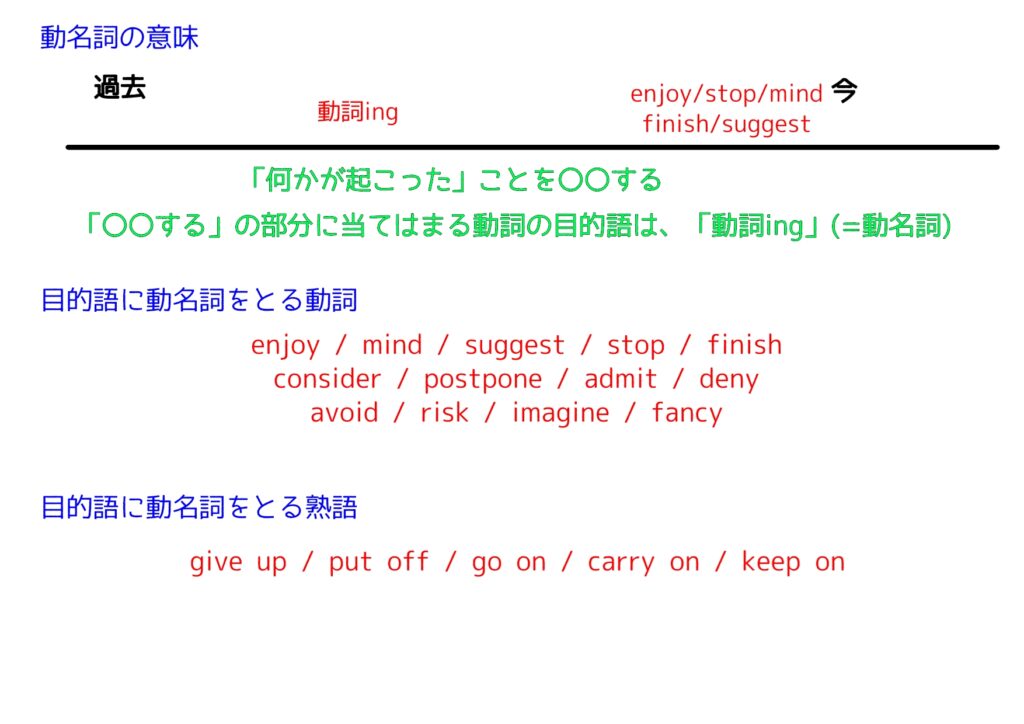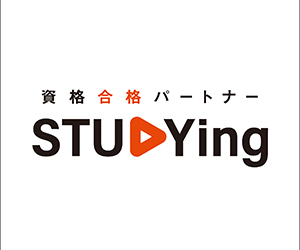第30回:動名詞の活用方法

基本的に、前置詞の後は、動詞のing形が続きますが、
その他に、どのような使い方があるかを見てみましょう。
Q. この記事で、一番大事なことって何?
A. 大事なことを、1枚の画像にまとめました。

いちいちノートにまとめるのが面倒だという方、また、
ノートにまとめることが苦手だという方は、ご活用ください。

[広告]
確かな英語力は、日々の継続から。
その継続を後押しする、第二言語習得理論に基づいた
オンライン英語学習プログラムがあります。
英語を使う人のための、確実なスキルアップが望める
7日間の無料体験はこちらから!

Q. そもそも、動名詞って何だ?
A. 動詞を名詞化したもので、
主語、目的語、補語などの役割を持ちます。
【1】動詞+ingで形成される 動名詞は、動詞の語尾に「-ing」を加えることで形成されます。例えば、「run」は「running」、「swim」は「swimming」となります。
【2】名詞としての役割を持つ 動名詞は、名詞としての役割を持ちます。例えば、以下のように主語として使うことができます。
- Running is good exercise.
- Swimming is fun.
【3】目的語として使われる 動名詞は、他の動詞の目的語として使われることがあります。例えば、「enjoy」という動詞の目的語に「running」という動名詞を使うと、以下のようになります。
- I enjoy running.
【4】前置詞の後ろに置かれる 動名詞は、前置詞の後ろに置かれることがあります。例えば、「for」の後ろに動名詞を置くと、以下のようになります。
- Thank you for running errands for me.
【5】形容詞や副詞の代わりになる 動名詞は、形容詞や副詞としての役割を持つことがあります。例えば、以下のように形容詞として使われることがあります。
- The running water is so relaxing.
また、以下のように副詞として使われることがあります。 - I go to the gym every day, running included.
以上が、動名詞の基本になります。動名詞は、名詞として、また、動詞の目的語として、前置詞の後ろに置かれることがあり、形容詞や副詞の代わりにもなります。英語を使いこなすためには、動名詞を正しく使いこなすことが重要です。
より細かい動名詞の使い方
- 「動名詞」は、多くの「like/dislike/hate/love/object to」といった動詞に続けて、動詞の後に直接接続することができます。また、名詞の所有格+「動名詞」の形式も存在しますが、よりフォーマルな表現とされています。
- 「動名詞」は、前置詞「to」を伴って使用されることがあります。「to」に続く「動名詞」は、主語が行う動作や状態を表します。
- いくつかの動詞は、「前置詞+動名詞」の』形になることがあります。「begin, close, end, finish (off/up), open, start (off/out)」などは、「by+ -ing」の形をとります。
- 「feel, hear, notice, observe, overhear, see, watch」といった動詞(知覚動詞)は、目的語の後に「動名詞」や「原形不定詞(動詞の原形)」を使うことができます。ただし、使う形式によって微妙な違いがあるため、文脈に合わせて使い分ける必要があります。
- 「dare, help」の後には、「原形不定詞(動詞の原形)」と「to+動詞の原形」のどちらも使用することができます。ただし、「have, let, make」の後には、「原形不定詞(動詞の原形)」のみを使うことができます。
具体例
- 目的語+動名詞
- I detest Tom smoking in front of me. (object + -ing)
- She dislikes her sister interrupting her while she’s working. (possessive + -ing)
- to(前置詞) + 動名詞
- He admitted to stealing the money from the bank. (to + -ing)
- Do you look forward to going on vacation next month? (to + -ing)
- 前置詞+動名詞
- We started by cooking dinner and then moved on to watching a movie. (by + -ing)
- Jack insisted on me wearing a tie to the wedding. (on + object + -ing)
- Have you ever heard of a student getting expelled for cheating? (of + -ing or of + object + -ing)
- 知覚動詞+原形不定詞
- I heard him sing a beautiful song. (bare infinitive)
- I saw the bird fly away from the tree. (bare infinitive)
- 原形不定詞
- She didn’t dare to confront her boss about the issue. (to-infinitive)
- He helped his friend move to a new apartment. (bare infinitive)
- I had my son clean his room before going out to play. (object + bare infinitive)
[広告]
TOEICのスコアを上げたいけれど、
まとまった勉強時間が取れなくて困っている…
なら、細かいスキマの時間を使いながら、
少しずつスキルを積み重ねてみてはどうでしょう。
スマホ1つでスコアアップが出来る、
オンライン講座のリンクはこちらから。

Q. この文法はどうやって使うのでしょうか?
A. 今回の文法を活用した会話文を見てみましょう。

Did you resent me winning the game yesterday?
(昨日の試合で私が勝ったのを妬んでいた?)

No, of course not. I actually enjoyed watching you play.
(いや、全然そんなことないよ。実際には、君がプレイするのを見てて楽しかったよ。)

Oh, I see. Mia recalled you buying the new tennis racket. Did you really like it?
(そっか。ミアは君が新しいテニスラケットを買ったことを覚えていたんだけど、本当に気に入ったの?)

Yes, I did. It’s been helping me improve my game.
(うん、気に入ってるよ。それが自分の試合の改善に役立っているんだ。)

That’s great. Anyway, Do you object to helping me clean up the house later?
(それは良かったね。ところで、後で家の掃除を手伝ってくれる?)

No, not at all. I’m happy to help.
(もちろん手伝うよ。)

Thanks. Can you begin by cleaning the floors, and then we can move on to the windows?
(ありがとう。まず床の掃除から始めて、その後窓に移ってもらえる?)

Sure, I’ll get started on that right away.
(もちろん、すぐに始めるよ。)
[広告]
ロゼッタストーン・ラーニングセンターで、最先端の教育制度を活用して英語を学びませんか?私たちは個々の学習ペースに合わせてeラーニングと対面教育を組み合わせ、柔軟な学習環境を提供しています。自宅でのeラーニングと対面教育のメリットを最大限に活かし、あなたの英語学習をサポートします。最新のテクノロジーと個別の指導が組み合わさった当センターで、自由な学習スタイルを体験してみませんか?英語学習を楽しく効果的に進めるための環境がここにあります。新たな一歩を踏み出して、新しい英語学習の旅に参加しましょう!

Q. この記事の要点は?
A. 動名詞の使い方を確認しました。
The article explains the usage of different verb forms – gerunds and infinitives. Some verbs can be followed by either an object + -ing or a possessive + -ing form, while some verbs take a preposition before the -ing form. Other verbs can take different prepositions before the -ing form. Some verbs can be followed by either an -ing form or bare infinitive, with a slight difference in meaning. After the verbs dare and help, both bare and to-infinitives can be used. However, after have, let and make, only the bare infinitive can be used with an object.
英会話を始めてみたいけれど、どのサービスが良いか分からない…
そんな方は、まず、この記事で3つのサービスを比べてみてはいかがでしょうか?
英語力を効率良く伸ばすことができるサービス3選です。

次回の文法解説は?
この記事を作る際に参考にした文法の解説書になります。
すべて英語で書かれていますが、練習問題が付いてます。
イギリス英語なので、スペル等の表記が異なる部分もありますが、
「使い方を練習したい」「繰り返し問題を解きたい」
という方は、使ってみても良いかもしれません。

関連記事一覧
他の文法解説記事を検索できます。





-320x180.jpg)






-120x68.jpg)

コメント